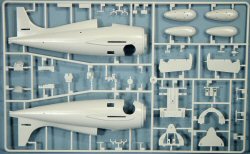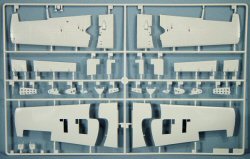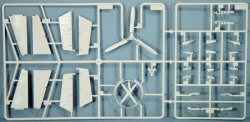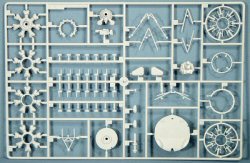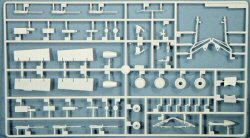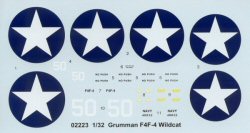Trumpeter 1/32 Grumman F4F-4 Wildcat | 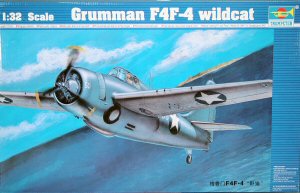 | Background The Grumman F4F Wildcat was the monoplane derivative of the F3F series. Designed around the standing carrier operations requirement, the F4F provided additional firepower, greater horsepower, and less lift as it lost the upper and lower wings of the F3F in favor of a fixed mid-wing configuration. In keeping with the F3F legacy, all versions of the F4F retained the non-folding wing until the advent of the F4F-4 and Goodyear-derivative FG series. The Kit As most of you know, Trumpeter released their F4F some months ago with an accuracy problem that generated enough heat on the internet that the company withdrew the kit pending a design review and subsequent corrections. Well, the second version of the F4F-4 is now available and I can report that they got the important parts correct. The kit is molded in standard Trumpeter light gray styrene and features the usual outstanding scribed details throughout the exterior surfaces of the kit. As usual with new Trumpeter releases, none of the gazillion parts trees have any residual molding flash. While I didn’t see the original release of this kit, I can tell you that Trumpeter has made some major design revisions in their molding. Where earlier kits featured some nice cockpit and interior details on the insides of their fuselages, they also required significantly more ejector pins to get the detailed trees off the mold and resulted in too many ejector pin marks in places where detail would be lost in order to remove the ejector pin marks. In this release of the F4F and the F4U Corsair reviewed elsewhere in this issue, Trumpeter designed the interior cockpit wall framing as separate parts resulting in fewer ejector pin marks inside the fuselage. Kudos to the engineers at Trumpeter! And because the interior details are now separate parts, it is a simple matter now to eliminate any offending ejector pin marks before installing the cockpit details. The kit also provides articulated landing gear struts and the now-classic photo-etched hinged flight control surfaces. While the photo-etched hinges sound good for allowing the builder to ‘position’ the flight controls, the reality is that all of them will follow the influence of gravity and droop, This looks natural on a fly-by-wire aircraft like an FA-18 Hornet, but not at all natural on a WW2-era aircraft. If one were to compare this kit to the only other 1/32 scale F4F-4 kit on the market, the venerable Revell kit, one would instantly notice four times the number of parts trees in the Trumpeter kit. The engine alone is so detailed that the Trumpeter designers also included a transparent cowling to enable you to show off the details. The wing-fold mechanisms also appear to be well thought out and nicely detailed. I did compare the Trumpeter kit with the Revell Wildcat and found that the wings, tail surfaces and the overall fuselage profile match up nicely. The one difference is in the slope of the nose ahead of the windscreen. You can see in the photo that the Revell nose extends out straighter while the Trumpeter nose slopes down more. I’ve checked my references and drawings and I have to say that Revell got their nose wrong and Trumpeter has captured the shape of the forward fuselage nicely. While I did not see the first release of the Trumpeter F4F, I understand that the nose slope was much closer to the Revell version. Conclusion This is a beautiful kit of the F4F-4 and I certainly hope that Trumpeter will consider adding additional parts in future releases to render the F4F-3 and FM-2. I have no doubt that the aftermarket crowd will address these variants as well. Since the wings fold nicely out of the way, you’ll have more room on your scale flightline to render the F4F-4 in its Pacific, North Atlantic, and Marlet color schemes. This kit is definitely recommended! My sincere thanks to Stevens International for this review sample! | 








|

